Novel, live attenuated simian immunodeficiency virus constructs containing major deletions in leader RNA sequences
- PMID: 11222701
- PMCID: PMC115902
- DOI: 10.1128/JVI.75.6.2776-2785.2001
Novel, live attenuated simian immunodeficiency virus constructs containing major deletions in leader RNA sequences
Abstract
We have constructed a series of simian immunodeficiency virus (SIV) mutants containing deletions within a 97-nucleotide (nt) region of the leader sequence. Deletions in this region markedly decreased the replication capacity in tissue culture, i.e., in both the C8166 and CEMx174 cell lines, as well as in rhesus macaque peripheral blood mononuclear cells. In addition, these deletions adversely affected the packaging of viral genomic RNA into virions, the processing of Gag precursor proteins, and patterns of viral proteins in virions, as assessed by biochemical labeling and polyacrylamide gel electrophoresis. Different levels of attenuation were achieved by varying the size and position of deletions within this 97-nt region, and among a series of constructs that were generated, it was possible to rank in vitro virulence relative to that of wild-type virus. In all of these cases, the most severe impact on viral replication was observed when the deletions that were made were located at the 3' rather than 5' end of the leader region. The potential of viral reversion over protracted periods was investigated by repeated viral passage in CEMx174 cells. The results showed that several of these constructs showed no signs of reversion after more than 6 months in tissue culture. Thus, a series of novel, attenuated SIV constructs have been developed that are significantly impaired in replication capacity yet retain all viral genes. One of these viruses, termed SD4, may be appropriate for study with rhesus macaques, in order to determine whether reversions will occur in vivo and to further study this virus as a candidate for attenuated vaccination.
Figures

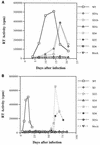
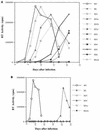

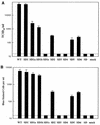
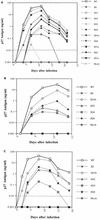
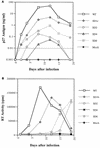


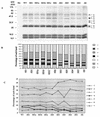
Similar articles
-
The M184V mutation in reverse transcriptase can delay reversion of attenuated variants of simian immunodeficiency virus.J Virol. 2002 Sep;76(17):8958-62. doi: 10.1128/jvi.76.17.8958-8962.2002. J Virol. 2002. PMID: 12163615 Free PMC article.
-
Impaired RNA incorporation and dimerization in live attenuated leader-variants of SIVmac239.Retrovirology. 2006 Dec 21;3:96. doi: 10.1186/1742-4690-3-96. Retrovirology. 2006. PMID: 17184529 Free PMC article.
-
Construction and in vitro properties of a series of attenuated simian immunodeficiency viruses with all accessory genes deleted.J Virol. 2001 May;75(9):4056-67. doi: 10.1128/JVI.75.9.4056-4067.2001. J Virol. 2001. PMID: 11287555 Free PMC article.
-
Comparison of regulatory features among primate lentiviruses.Curr Top Microbiol Immunol. 1994;188:123-44. doi: 10.1007/978-3-642-78536-8_7. Curr Top Microbiol Immunol. 1994. PMID: 7924423 Review. No abstract available.
-
Translation and replication of FMDV RNA.Curr Top Microbiol Immunol. 2005;288:43-70. doi: 10.1007/3-540-27109-0_3. Curr Top Microbiol Immunol. 2005. PMID: 15648174 Review.
Cited by
-
The M184V mutation in reverse transcriptase can delay reversion of attenuated variants of simian immunodeficiency virus.J Virol. 2002 Sep;76(17):8958-62. doi: 10.1128/jvi.76.17.8958-8962.2002. J Virol. 2002. PMID: 12163615 Free PMC article.
-
Multi-low-dose mucosal simian immunodeficiency virus SIVmac239 challenge of cynomolgus macaques immunized with "hyperattenuated" SIV constructs.J Virol. 2010 Mar;84(5):2304-17. doi: 10.1128/JVI.01995-09. Epub 2009 Dec 23. J Virol. 2010. PMID: 20032177 Free PMC article.
-
The simian immunodeficiency virus 5' untranslated leader sequence plays a role in intracellular viral protein accumulation and in RNA packaging.J Virol. 2003 Jun;77(11):6284-92. doi: 10.1128/jvi.77.11.6284-6292.2003. J Virol. 2003. PMID: 12743285 Free PMC article.
-
Emergence of simian immunodeficiency virus-specific cytotoxic CD4+ T cells and increased humoral responses correlate with control of rebounding viremia in CD8-depleted macaques infected with Rev-independent live-attenuated simian immunodeficiency virus.J Immunol. 2010 Sep 15;185(6):3348-58. doi: 10.4049/jimmunol.1000572. Epub 2010 Aug 11. J Immunol. 2010. PMID: 20702730 Free PMC article.
-
Impaired RNA incorporation and dimerization in live attenuated leader-variants of SIVmac239.Retrovirology. 2006 Dec 21;3:96. doi: 10.1186/1742-4690-3-96. Retrovirology. 2006. PMID: 17184529 Free PMC article.
References
-
- Almond N, Kent K, Crannage M, Rud E, Clark B, Stott E J. Protection by attenuated simian immunodeficiency virus in macaques against challenge with virus-infected cells. Lancet. 1995;345:1342–1344. - PubMed
-
- Baba T W, Jeong Y S, Pennick D, Bronson R, Greene M F, Ruprecht R M. Pathogenicity of live, attenuated SIV after mucosal infection of neonatal macaques. Science. 1995;267:1820–1825. - PubMed
-
- Baba T W, Liska V, Khimani A H, Ray N B, Dailey P J, Penninck D, Bronson R, Greene R, Greene M F, McClure H M, Martin L N, Ruprecht R M. Live attenuated, multiply deleted simian immunodeficiency virus causes AIDS in infant and adult macaques. Nat Med. 1999;5:194–203. - PubMed
-
- Boykins R A, Mahieux R, Shankavaram U T, Gho Y S, Lee S F, Hewlett I K, Wahl L M, Kleinman H K, Brady J N, Yamada K M, Dhawan S. Cutting edge: a short polypeptide domain of HIV-1-Tat protein mediates pathogenesis. J Immunol. 1999;163:15–20. - PubMed
-
- Chackerian B, Haigwood N L, Overbaugh J. Characterization of a CD4 expressing macaque cell line that can detect virus after a single replication cycle and can be infected by diverse simian immunodeficiency virus isolates. Virology. 1995;213:386–394. - PubMed
Publication types
MeSH terms
Substances
Grants and funding
LinkOut - more resources
Full Text Sources
Research Materials

